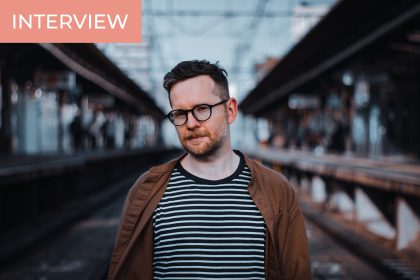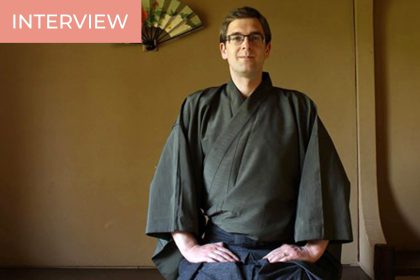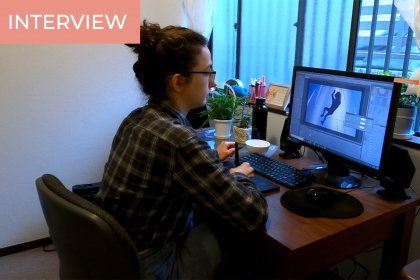As you may know, in Japan, summer is the season of ghosts. Traditionally, obon is when spirits come back to earth, and in September, ohigan is when the world of spirits and the world of the living are the closest. The heavy atmosphere due to the heat and humidity is also perfect to tell scary stories and watch horror movies.
That is why it is the perfect moment to introduce you to the independent movie “Orange Juice” which, despite its cute name, is a horror movie that aims for blending the best qualities of Japanese horror movies and Hollywood ones.
This interview has an unusual format as I have asked many members of the crew, including the director, special effects and makeup artists, and actresses. Discover what motivates each member to be involved in the film, and their unique point of view on J-horror.
About the Horror Movie “Orange Juice”
For a better understanding of the interview, here is the movie plot as summarized on their crowdfunding page:
“After the death of her estranged mother, Nanami is forced to liquidate her mother’s house.
She is accompanied by her best friend, Yui, who understands her feelings, and her four friends, Ryo, Sakura, Ayaka, and Takuma, who are also on a trip to film their entry for the ‘Occult Video Award.’
Something is wrong with the mother’s house, but the six young people stay in the house despite feeling uncomfortable. It turns out to be a cursed mansion that they cannot leave alive: they are killed one after another.
What is the real reason behind Nanami and her mother’s estrangement?
What is the secret behind the words ‘orange juice’?
Yui and Nanami must face the deadly spirit that haunts the mansion in order to return home alive.”

Masahiro Hamakawa – Direction, Production, Editing

How does a Hollywood-produced horror film differ from a “J-horror” film?
A lot of Japanese horror movies are based on the grudge of a spirit, while in Hollywood horror movies, the enemy is often a devil. Hollywood movies also have a lot of monsters or killers who kill the protagonists one after the other, such as in “Friday the 13th” for example.
In the American remake version of “Ring,” Sadako’s character is quite different in my opinion, and became closer to a monster as seen in American culture. Since ancient times, Japanese culture has had a lot of stories about apparitions and spooky tales. For example, the story of Oiwa-san [see our article about her story here], or the story of “Bancho Sara-yashiki.” Japanese stories are mostly based on resentment and anger.
What is unique about the “Orange Juice” movie that you are currently filming?
I have always loved Hollywood movies, and I watch a lot of them. At the same time, I love Japanese horror movies. However, although some of them are fun, most of the time, they are very dark, especially the ones with a low budget. As if “dark” necessarily meant “scary.” Because of this, the tempo is often weak. So, I would like to make a movie that has a good tempo like American horror movies, while dealing with grudges and resentment typical of Japanese culture.
You produce, direct, and edit films. What do you enjoy most about filmmaking, and what is the most difficult part?
I write the script first and imagine how I could turn it into images to make it entertaining. But finding places that fit the scenario and what I imagine is extremely difficult! For example, in an action movie that I made before, there was a building in the forest that was used as the bad guy’s hideout. It took me more than half a year to find it!
There are a lot of filming location services that can provide you with buildings or forest locations, but they are very expensive. So, I do a lot of research on the internet. For example, I look at forest pictures, and if I find one that I like, I search for who owns it. For forest scenes, a cheap solution is to rent parks by contacting city halls. Some municipalities have film commissions and are doing their best to revitalize the area using movies. They let us rent places more easily. We are based in Saitama Prefecture, and Ageo City has a very good film commission. They allowed us to film in front of the train station, for which it is very difficult to get permission in Japan.
Because of this, I am always on the lookout for interesting places and take a lot of pictures, so that they can come in handy later when I write the script.
The most enjoyable part is filming the movie. There are also a lot of hardships, like when I am not able to film the scenario as I wanted, or it does not come out as I imagined. Still, I am surrounded by a crew that has the desire to make a good movie and accepts to do what I say. Also, there are a lot of things that we cannot know until we film it for real, especially regarding acting, even though there are auditions. So when everything seems to be coming together, I feel extremely happy.
Filming together is fun, but we have limited time to do so, for example, we need to hurry to film a day scene before the sun comes down. That is why I also appreciate the editing work because I can do it alone until it is finished.
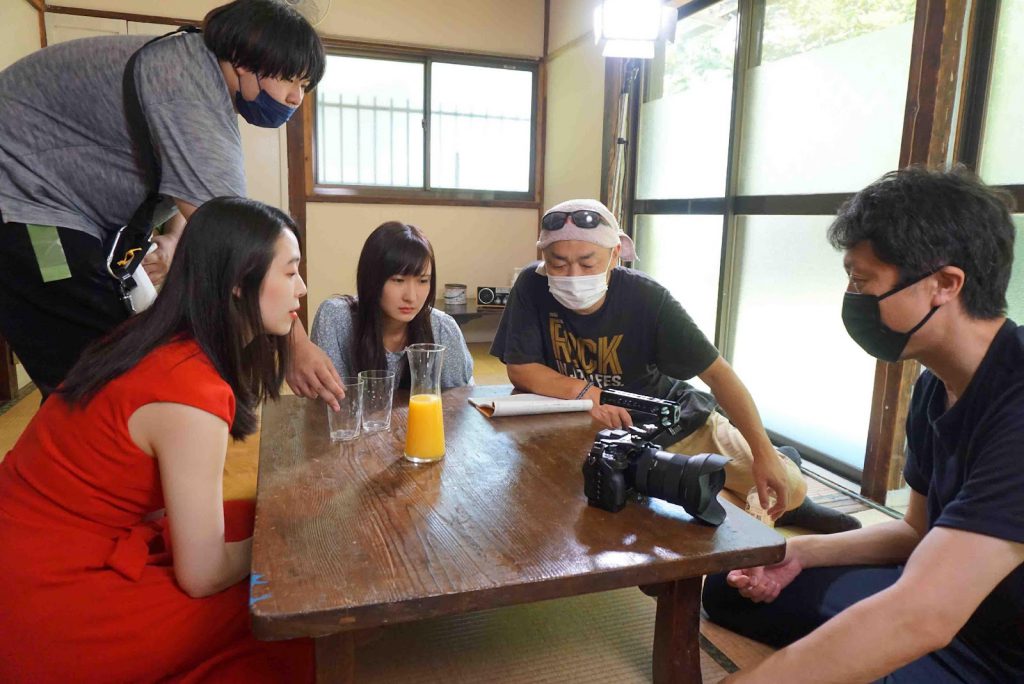
What do you want to convey through your movie “Orange Juice”?
Of course, there is the theme that I evoked earlier. I also want to show how the movie’s characters progress and change their way of thinking throughout the story.
But, most of all, I want to show how entertaining a movie can be by mixing the Western and Eastern movie styles. In the world of independent movies, many people consider movies as art pieces. For me, it is more about entertainment. My main objective is to make a movie the spectators will have fun watching for an hour and a half.
To be honest, we are working on a low budget, so I have put a lot of energy into making sure that it does not show right from when I start writing the script.
For this movie, you insist on using SFX [special effects] rather than VFX [visual effects]. Why is that?
Nowadays, it is common to use VFX, which is special effects made with a computer. For example, in our movie, there will be a scene in which a head is severed. If you make this with computer-generated imagery, you can show it in one take. That is one way to do it.
In the ‘80s, movies did not use such effects because they hardly existed and were very expensive. Instead, they use the actors’ talents in acting and filming techniques.
With CGI, when you are filming, you cannot see what is happening, you have to act and pretend that you do. It’s like filming a kaiju [Japanese giant monster] movie without a kaiju. You can only use your imagination. CGI is often used even for scenes in which people are shot and blood pours because it is so bothersome to clean up fake blood!
On the contrary, I want to show my actors what is happening and make them feel it. I want the filming set to be real and scary.
Anna Nakano – Special Effects
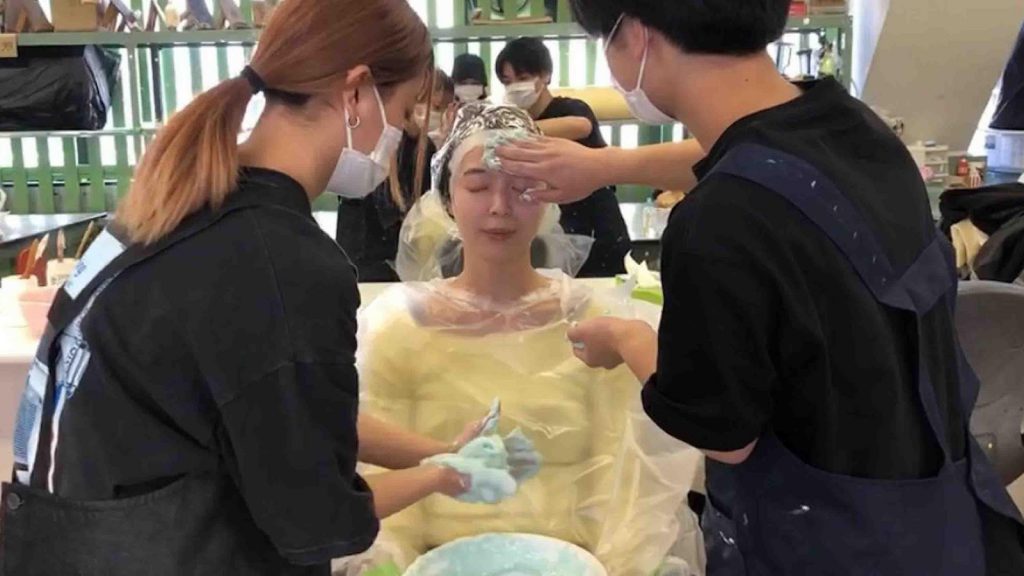
What are the appeal and benefits of SFX?
I agree with everything that our director just said. I would also like to add that I think special makeup effects can help the actors play their role, too.
There is a famous special makeup effects artist called Kazu Hiro [Editor’s note: he was previously called Kazuhiro Tsuji]. In his book, he explains applying makeup on famous actor Gary Oldman for “Dawn of the Planet of the Apes.” He asked him if special makeup effects were better than CG. Gary Oldman said that by looking like a real ape thanks to makeup, it was easier to play his role and that he was able to give his best performance.
You are currently a student at a school of special effects. What made you decide to study there?
Thanks to my father, I have loved movies since I was a child. I also have always liked drawing and doing fine work. I was thinking about a job that would fit these two aspects of my personality, and that is how I chose special effects makeup.
In the movie, there will be a scene including a severed living head. How do you make that in SFX?
First, we make a mold of the head of the actor who will have their neck cut. Then, we make a sculpture of the wound when the neck is damaged, and also make a mold of it.
Then, we pour soft urethane into it and wait for it to harden. We remove it from the mold, put color onto it, and add a wig. We also make a tube go through the neck to be able to make blood come out.
Faïza Dejaeghere – Makeup

How is working with makeup for a horror movie different from working with makeup for a general movie?
There are a lot of common points. In general movies too, makeup is necessary to make the character’s personality fit with the scenario. For example, a delinquent girl will not wear the same makeup as a gyaru. So, there is a lot of research to be done after reading the script. There are also lighter effects like making a face look paler if they are sick, or putting some dirt on a protagonist’s face after they fall in a scene. Having the makeup change depending on the scene is a main common point between general movies and horror movies.
Horror movies are special in the sense that wound makeup, for example, is necessary when filming violent scenes. You have to make it look real so that the spectator believes it. Another specificity is making makeup for creatures that do not exist: ghosts, monsters, vampires. There are many kinds and many versions, as the way they look may change depending on the country and the culture. So, it is important to think seriously about their design, which I make after reading the script and talking with the director.
In terms of special makeup, what is the difference between Japanese and Hollywood horror films?
Like most people, my typical view of Japanese horror is the character of Sadako in “Ring.” However, the ghosts’ makeup varies a lot depending on the movie and what you want the audience to feel. That is why in Sadako’s case, the Japanese version and the American version look so different.
The original Japanese version respects the codes of J-horror and represents a “yurei” [Japanese ghost] with white skin and black eyes. The impression is more grotesque which is emphasized with the character’s movement. In the US version, Sadako’s character is close to a Western version of the ghost: a rotting corpse, almost a zombie. Her skin is not smooth like in the Japanese version but with a lot of scabs to reinforce the fear provoked by the ghost. The fear is not felt the same way in the US and in Japan, and the makeup needed to be adapted to frighten the Western audience.
Our director talked about Kayako earlier, and “Ju-On” also got its US remake called “The Grudge.” In these movies, the difference in makeup is less obvious and that is because the Japanese director made both the Japanese and American versions. The makeup is similar and some scenes are also the same.
Do you have any favorite works in Japanese horror?
I watched “Ring” when I was in high school. Sadako was a really spooky ghost, and the way she moved was really scary.
Sato Haruna and Mun Tsukino – Acting: The Two Heroines
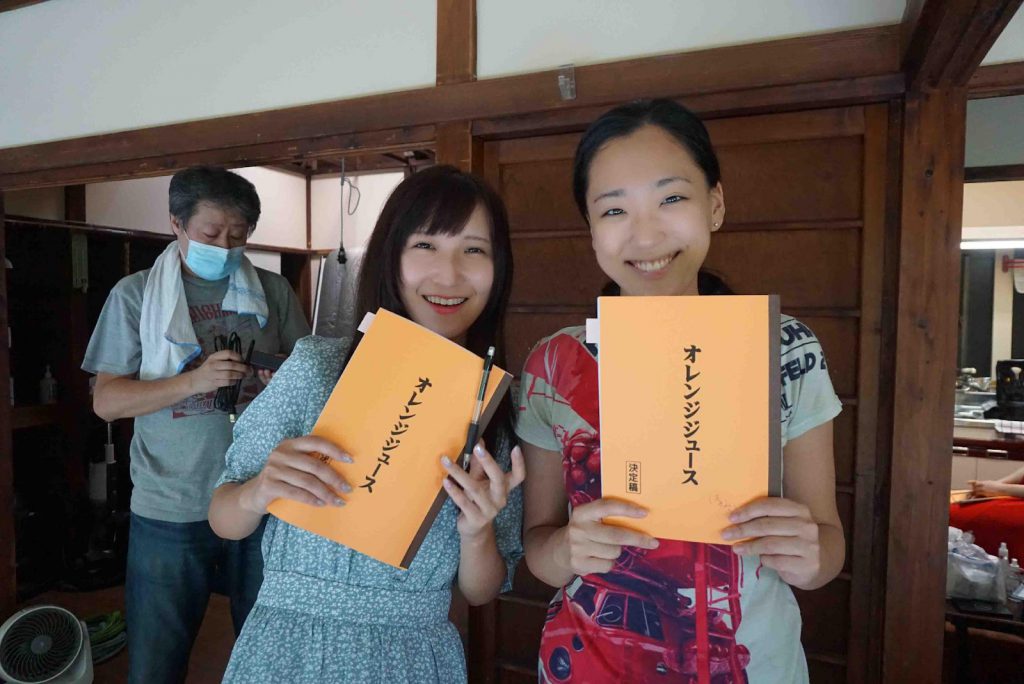
Is there anything that you keep in mind when playing a heroine in a horror movie?
Sato Haruna: In my case, I try to be very careful with my acting so that my character is in contrast with Mun’s acting and character. Yui, my character, and Nanami, whom Mun plays, have very different personalities. In real life, there are also people who are good friends although they have very different temperaments. I want the audience to feel it, and that the two girls fit nicely together.
Mun Tsukino: It’s the first time I play in a movie with double heroines, so I care about the same things Haruna said. The two heroines are completely different in character and in appearance. I want to act in a way that we put each other into the light without making our own characters fade.
Also, in horror movies, there are scenes in which you must act frightened or possessed. There are feelings that I must portray although I have never experienced them in real life. Nanami plays the main role in this story, so instead of merely reacting to what happens, I want to show how the atmosphere of a scene changes in Nanami’s presence, and want to give meaning to each of her gestures.

What would you like the audience to feel most through the role you are playing this time?
Sato Haruna: Since Nanami owns the story the most, I feel Yui’s role is to help Nanami’s story to reach the audience. I also want to show the students’ carelessness as they go to a scary place without thinking seriously about it. At the same time, I want to show that when trouble starts happening, they are able to think and act thoughtfully even if we do not expect them to do so. I think it is typical of people their age and I want to express that.
Mun Tsukino: Nanami is introverted and she is easily affected by events that happen around her, but I also want to show her strong core, like the fact that she resolves unfortunate events herself by understanding her past. I hope the audience will relate to it.
Kyoko Kudo – Acting: The Ghost
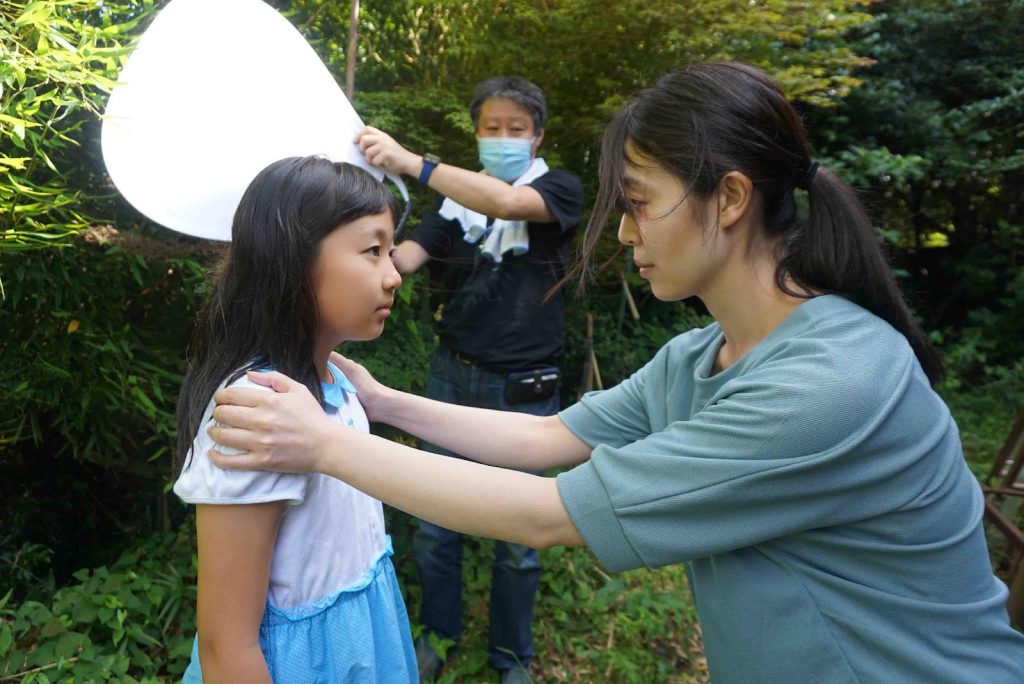
What is the secret to expressing the fear provoked by ghosts?
To tell the truth, I am a person who is easily scared. Since I was a child, I have always watched horror movies while covering my eyes. So, when I was told I would play a frightening role, I thought I would put to good use all my experience of being afraid. It can come from everyday experiences, like when my mother’s angry face felt scary, when I was afraid of insects’ legs, or when the voices I heard in nightmares scared me. I want to put parts of my diverse frightening experiences into my role.
This is the first time you have done special makeup on your face. How was it?
It was my very first experience with special makeup effects. I was very nervous when I was told they were going to make a cast of my head, and I wondered what they were going to do. The sensation was like having a cold, mint chewing gum all over the face. It covered both my eyes and my face. I could only breathe using my nose, so it was a little bit scary too. I was told to exhale air strongly through my nose if I was not able to breathe. I had to wait like that for 30 minutes. Thankfully, everything went without trouble and we were able to make a beautiful mold of my face. I was really amazed.
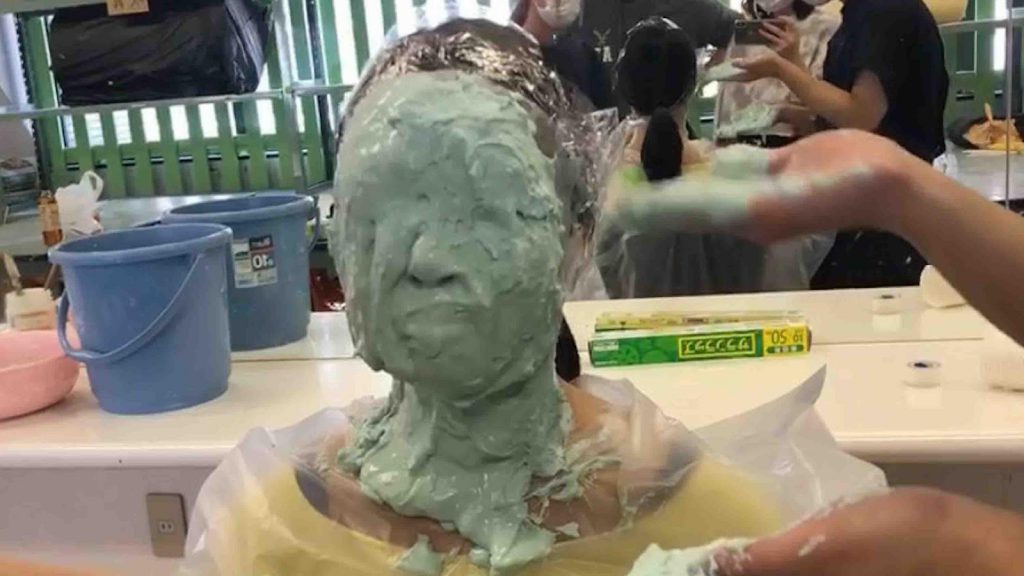
How did you feel looking at yourself in the mirror with the ghost makeup on?
At first, it was very fun, and I was happy to take pictures of the wounds that Faïza created on my face. But, when I looked at the pictures after I came home, it scared me! [laughs] It was scarier after taking a little distance from it.
The Scariest Ghosts

What is the scariest monster or ghost in J-horror and Japanese ghost stories?
Masahiro Hamakawa: In terms of spookiness, for me, it is Kayako [the main ghost in the Ju-On movies]. However, she is the scariest not in the “Ju-On” movies, but in the direct-to-video movies the director filmed before that. The first one is especially scary. They had a very little budget at the time, so the spookiness comes mostly from the actress’ wonderful acting. She is extremely scary because we do not know what she is going to do. Contrary to Sadako, her objective is unclear. If you have the chance, please watch it!
Anna Nakano: For me, it’s Kuchisake-onna [“the Slit-Mouthed Woman”]. This urban legend was really popular among kids when I was in elementary school. I was afraid every day on my way home, anxious that I would meet her. Kids said she was surely in the parks’ restrooms. It really scared me.
Faïza Dejaeghere: Just like Ms. Nakano, I am quite afraid of Kuchisake-onna. They even made movies about her. The way her mouth is slit is really spooky.
Sato Haruna: On Japanese TV, there is a show called “Yo ni mo Kimyo na Monogatari” [Tales of the Unusual]. It is a collection of weird stories. About 20 years ago, there was the story of “Zundoko Beroncho.” In the story, everybody talked about how terrific that “zundoko beroncho” is, but as a viewer, we do not know what it is until the end. For me, the fact of not knowing what everybody is talking about is the scariest.
Mun Tsukino: Like our director, for me, the scariest character is Kayako. I love watching scary movies. The scene when she comes down the stairs really made me feel I was looking at something that is not human. It left a huge impression on me. In real life, I find the fact that some people cast curses onto other people very scary.
Kyoko Kudo: To me, the scariest ghost is the one that I saw. I was in bed, and it came from above. I tried to wake up my mother who was sleeping next to me, but she would not wake up.
To describe that ghost, I would say it looked a lot like Kurokami [the Black Hair] in “Kwaidan” written by Lafcadio Hearn. When I watched the 1964 movie based on it by director Masaki Kobayashi, the lady in Kurokami looked a lot like the ghost I had seen. She turned into a skull with black hair waiting for her man to come back. When I saw it, it gave me shivers.
Final Remarks About “Orange Juice”

Interviewing so many people at the same time was a first for me. It was fun to talk to them and realize that although they work on the same project, each team member has a background and character very different from the others’. However, despite these differences in personalities and roles in the crew, it was very clear that each member is sending their best thoughts and best energy towards the same objective: making “Orange Juice” the best movie possible.
To write this article, the director allowed me to read the full script. The story is very well-paced indeed, and each scene has its reason to be in the movie. Although I could only imagine the scenes in my head, there was really no time to get bored. On top of that, the script offers a couple of surprises that I will not disclose here. I cannot wait to see the movie when it comes out!
If everything goes well, “Orange Juice” shall be released in October 2021, but it may come out later due to the state of emergency and the pandemic. As the director stated in the interview, the crew is working on a tight budget. However, if you like their project, do not hesitate to support them through their crowdfunding page. If the first level of crowdfunding is reached (600,000 yen – approximately 5,500 dollars), the movie will have English subtitles.
Until then, I will be watching previous short movies directed by Mr. Hamakawa on YouTube. Here is a very nice and scary one entitled “Futari Dake no Dosokai” [“A Class Reunion Only For the Two of Us.”]
The story: Ayumi’s company has transferred her to the town where she used to live as a middle school student. After moving into her new apartment, she receives an invitation to a middle school class reunion. Soon after, the haunting begins… This movie is a good example of how ghosts look in J-horror movies, as well as the explorations of the themes of grudge and remorse that Mr. Hamakawa explained in the interview. Enjoy!


